Welcome to the Field Guide to Spanish Peacock spindles! This page catalogs the various types of Spanish Peacock spindles, and the key characteristics of each. Originally a live stream on Facebook, this written version will get updated and elaborated on as time passes, and thus will be a “living” document. (You can also watch the live stream video version on Facebook.)
The simplest form of spindles are shaft-only, with no separate whorl. Even for such a simple concept, though, there are many variations – both historically, and in terms of Spanish Peacock spindles.
Russian Lace Spindle

Length Range: 10″ – 12″ (the typical length)
Weight Range: 16 g to 40 g, although they tend to be lighter these days than they have in the past, due to more delicate shaping of the shaft
Characteristics: A supported spindle. A slight bump low on the shaft gives it some extra weight for momentum, but much less than you’d get with a “real” whorl. Heavier woods (cocobolo, ebony, etc) may have more momentum, but will spin slower. Rarely, a Spanish Peacock Russian lace spindle will have a different wood for the tip, versus the rest of the shaft.
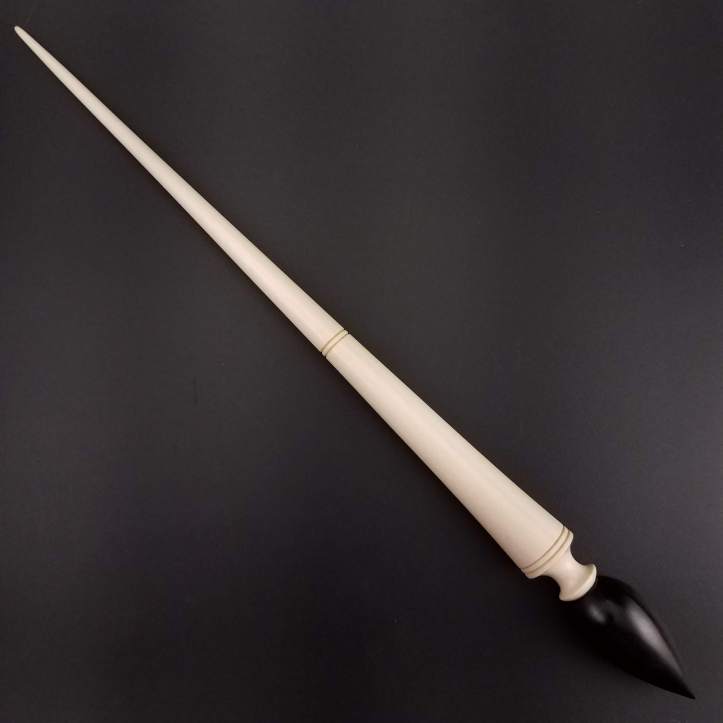
Pocket Russian Spindle
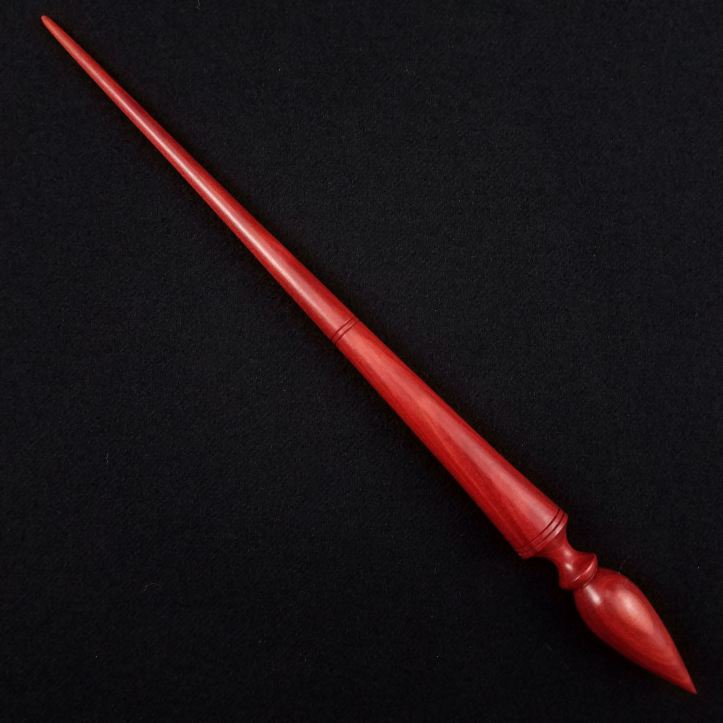
Length Range: approximately 9″
Weight Range: 7 g to 16 g
Characteristics: A supported spindle. Originally intended as Christmas ornaments, Mike continued to make them since customers insisted you could spin with them! Pocket Russians are very lightweight, with almost no momentum, meaning you have to flick constantly while spinning to put twist into the singles yarn as you spin. I do not recommend a pocket Russian for beginning supported spinners.
Phang
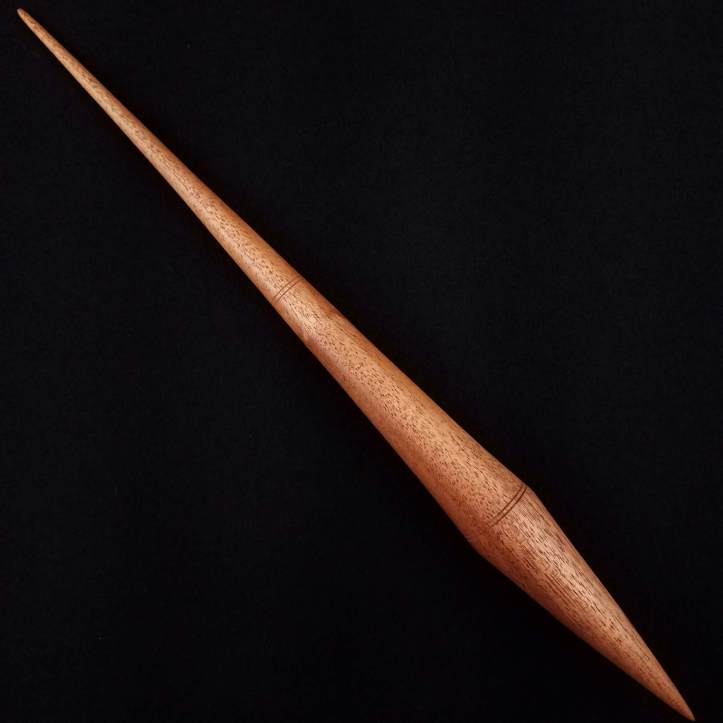
Length Range: 12″
Weight Range: 22 g to 26 g
Characteristics: A supported spindle. Loosely inspired by the traditional hand carved spindles from the Ladakh region of India. Even simpler in shape than the Russian-style lace spindles.
French Antique In Hand Spindle
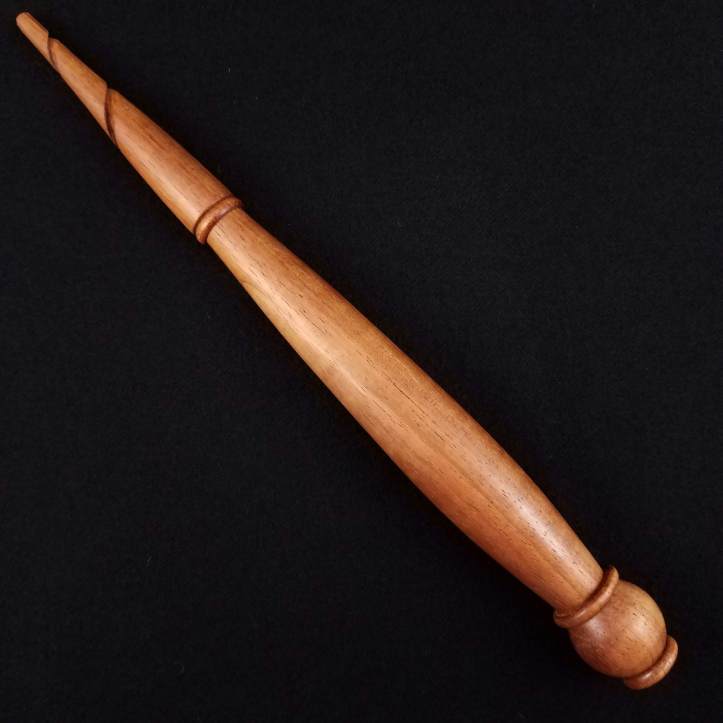
Length Range: 10″
Weight Range: 40 g to 46 g
Characteristics: An in-hand spindle, neither fully supported nor fully suspended. The spinner’s hand continuously twiddles or flicks the spindle, letting go for only brief moments. The groove in the top of the spindle allows the singles yarn to come off the tip near the center of the shaft.
Dealgan or Dealagan

Length Range: 8″
Weight Range: 27 g to 41 g
Characteristics: A Scottish suspended spindle, also called a farsadh. The singles yarn wraps around the shaft and then under the base, through one of the grooves, and then secures with a half-hitch around the knob at the top of the spindle. As the cop builds up, it is would around the shaft similar to how one winds a nostepinne.
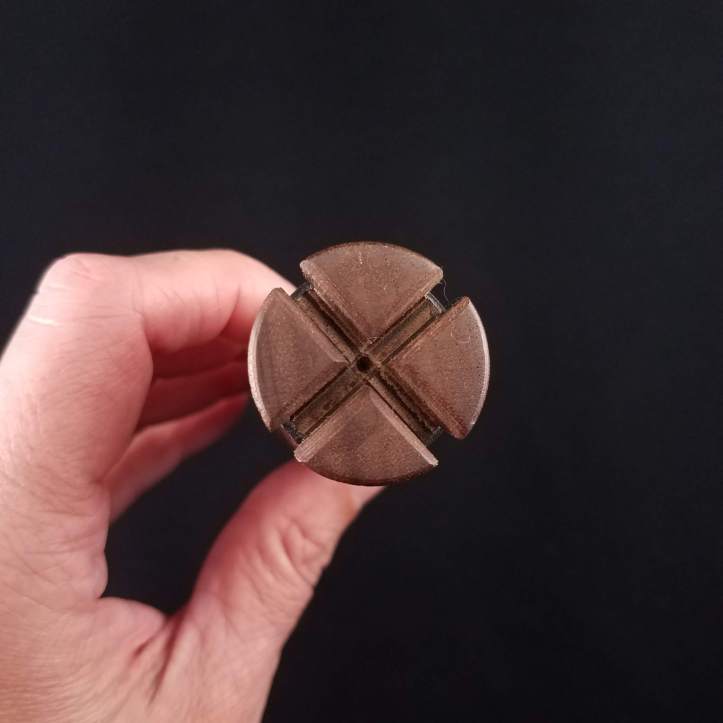
Victorian Ladies Silk Spindle

Length Range: 8.5″
Weight Range: 23 g to 43 g
Characteristics: A suspended spindle. Inspired by the “Ladies Silk Spindle”, a late-18th century aristocratic past time as described in Bette Hochberg’s Handspindles. (No, 18th century is not “Victorian”… but this is still what everyone calls it. If anyone knows of a painting depicting this shape of spindle from any era, we’d love to hear from you!) The pig tail hook allows the singles yarn to feed off the top of the spindle very close to the shaft, reducing the wobble one encounters in some top whorl spindles.
A slightly more complicated – and efficient – spindle comes from adding a whorl to the shaft. Whorls add weight and increase momentum while spinning.
Bead Spindle

Length Range: 11″
Weight Range: 13 g to 40 g
Characteristics: A supported spindle. The small whorl, close to the shaft, produces a fast spin and a high-twist fiber. Historically speaking, the whorls were made of bone, clay or metal; as far as we are aware, the Spanish Peacock was the first modern spindlemaker to create the bead whorl out of contrasting wood. While many bead whorls are round, other shapes do exist.
**Generally speaking, beads or Tibetans are my best recommendations for folks first learning to spin supported.
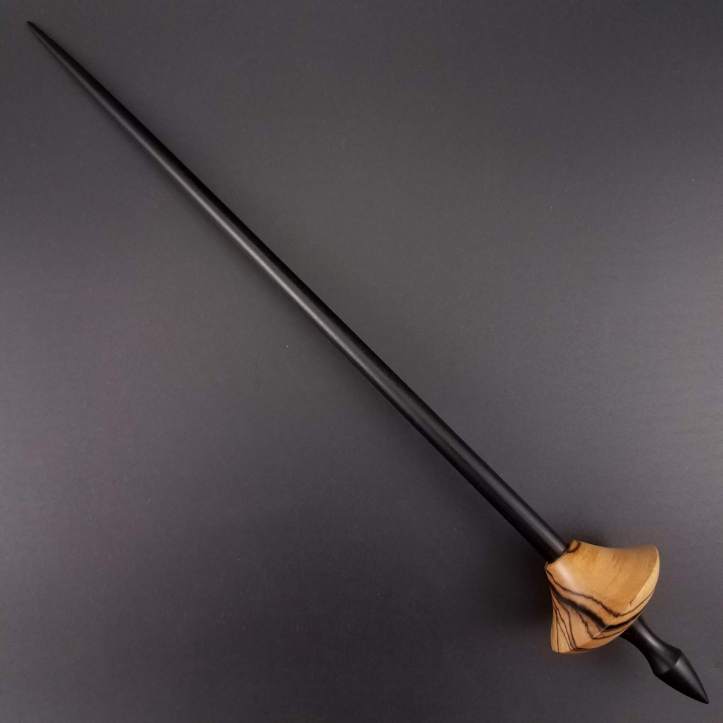
Pocket Bead Spindle

Length Range: 9″
Weight Range: 13 g to 25 g
Characteristics: A supported spindle. The pocket bead has a shorter shaft and smaller whorl than a “typical” bead. It generally weighs less and is easy to travel with; however the shorter shaft leaves less room to build a cop.
Here is a photo showing a full size and pocket bead together, to provide a sense of scale.

Tibetan Spindle

Length Range: 10.5″ to 12″ (the typical length)
Weight Range: 21 g to 44 g
Characteristics: A supported spindle. The wider, cup-shaped whorl creates even more momentum than a bead; however the weight distributed away from the shaft also makes for a slightly slower spin. Tibetan spindles also have a thicker, longer shaft than bead spindles, which some spinners prefer. Some shape variations are seen besides the standard smoothly curved cup shape.
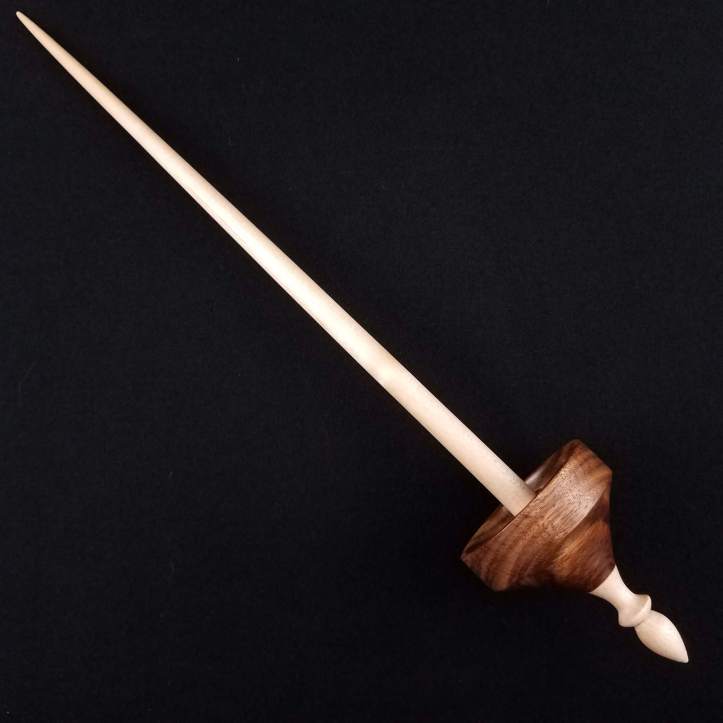
**Generally speaking, beads or Tibetans are my best recommendations for folks first learning to spin supported.
“Bob” Spindle
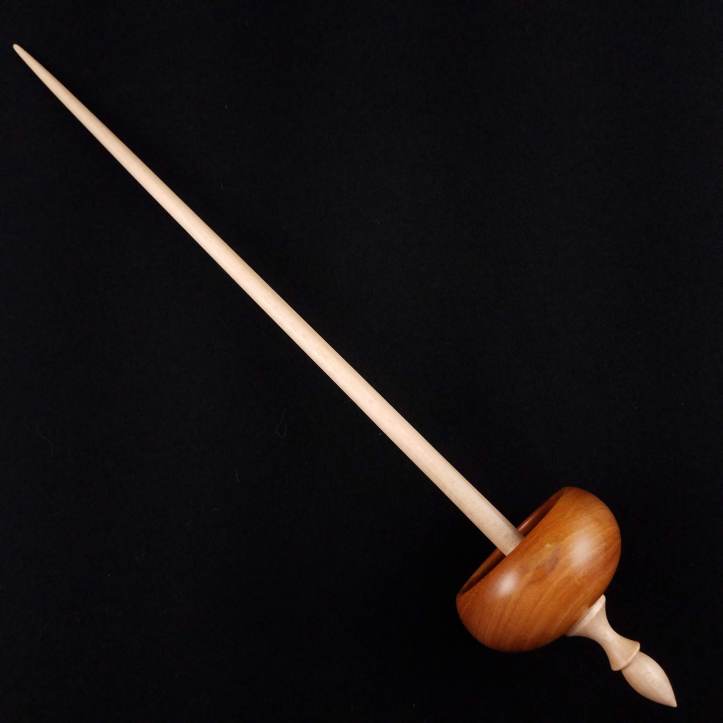
Length Range: 12″
Weight Range: 22 g to 44 g
Characteristics: If you turn the rim-weighted effect up to an 11, you get the “Bob”. Technically Bob is a variation of a Tibetan, and will be listed as a Tibetan on the Spanish Peacock website. However the shape (and the description) make it clear this is a Bob rather than a “standard” Tibetan. Thanks to the wide, shallow whorl, these spindles spin FOREVER. On average, however, the tend to be heavier than their Tibetan brethren.
Pocket Tibetan Spindle
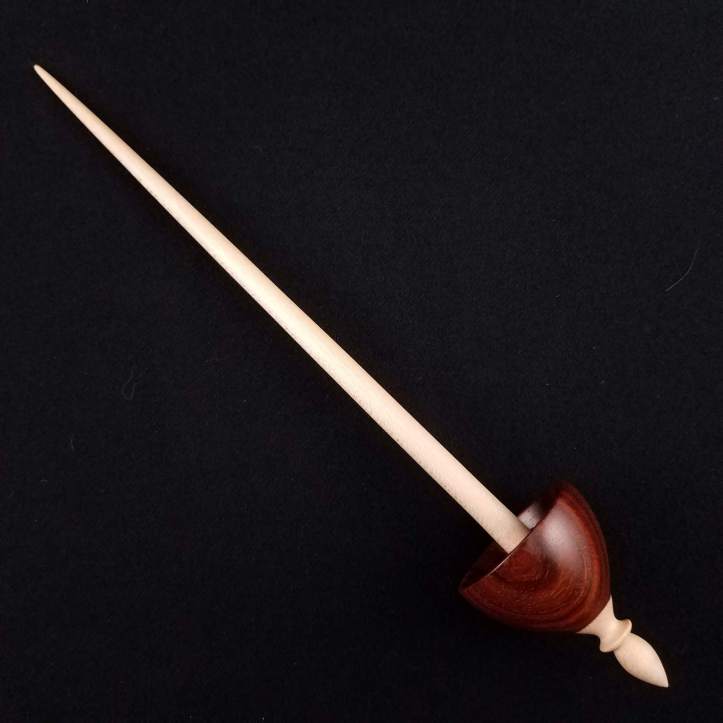
Length Range: 9″
Weight Range: 12 g to 27 g
Characteristics: A supported spindle. Similar to the pocket bead, this is a travel-sized, portable version of the Tibetan spindle.
Here is a photo showing a full size and pocket bead together, to provide a sense of scale.

Ninja Spindle

Length Range: 11″
Weight Range: 15 g to 32 g
Characteristics: A supported spindle, originally named the New Age Mutant Nina Spindle because it was a hybrid of the bead and Tibetan shapes, on the smaller / shorter shaft of a bead. The small, round but hollowed-out whorl creates a spindle which is both wicked fast and had a long spin.
Length Range: 11″
Weight Range: 15 g to 32 g
Characteristics: A supported spindle, originally named the New Age Mutant Nina Spindle because it was a hybrid of the bead and Tibetan shapes, on the smaller / shorter shaft of a bead. The small, round but hollowed-out whorl creates a spindle which is both wicked fast and had a long spin.

**While this is my personal favorite style of spindle, I do not recommend them for new supported spinners. The combination of speed and momentum will overtwist the singles yarn if you can’t draft fast enough!
Pu Yok

Length Range: 12.5″ to 13″
Weight Range: 16 g to 41 g
Characteristics: The largest Spanish Peacock supported spindle. The wide, flat whorl gives this spindle a slow and graceful spin, which makes it my go-to spindle for demonstrations. The shape of the whorl also means we can engrave it with designs for added character.

You can find a video of me spinning with my pu yok here.
Small Bottom Whorl
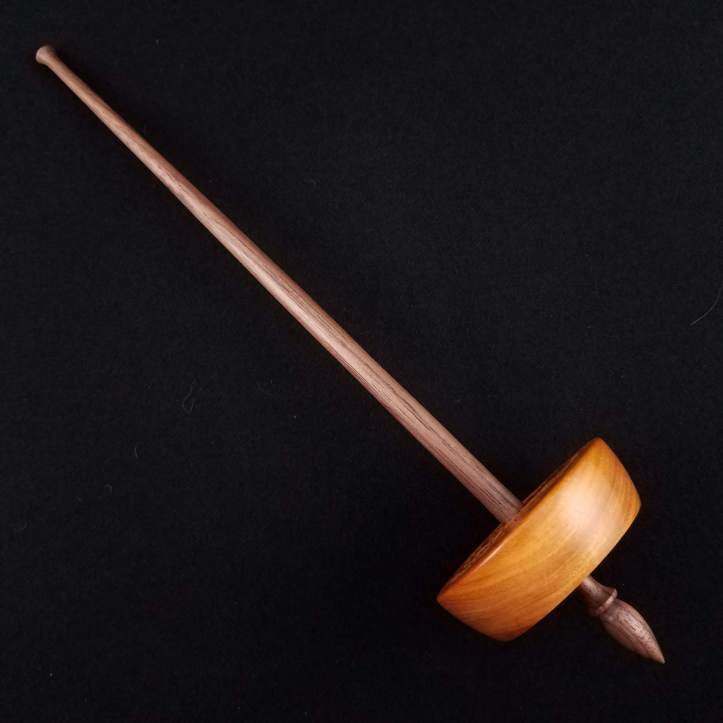
Length Range: 9″ (ish)
Weight Range: 19 g to 34 g
Characteristics: Can be used either supported or suspended via a half-hitch around the knob at the top of the shaft. Occasionally Spanish Peacock bottom whorls have hooks instead. The whorl averages 2.25″ in diameter. Small bottom whorls, like pu yoks, can also be engraved.

Large Bottom Whorl

Length Range: 10″ (ish)
Weight Range: 27 g to 35 g
Characteristics: Can be used either supported or suspended via a half-hitch around the knob at the top of the shaft. Occasionally Spanish Peacock bottom whorls have hooks instead. The whorl averages 3″ in diameter. Large bottom whorls can also be engraved.
Here is a photo showing a small and large bottom whorl together, to provide a sense of scale.

Small Top Whorl

Length Range: 9″ (ish)
Weight Range: 16 g to 36 g
Characteristics: A suspended spindle. The pig tail hook allows the singles yarn to feed off the top of the spindle very close to the shaft, reducing the wobble one encounters in some top whorl spindles. The whorl averages 2.25″ in diameter. Small top whorls can also be engraved.

Large Top Whorl
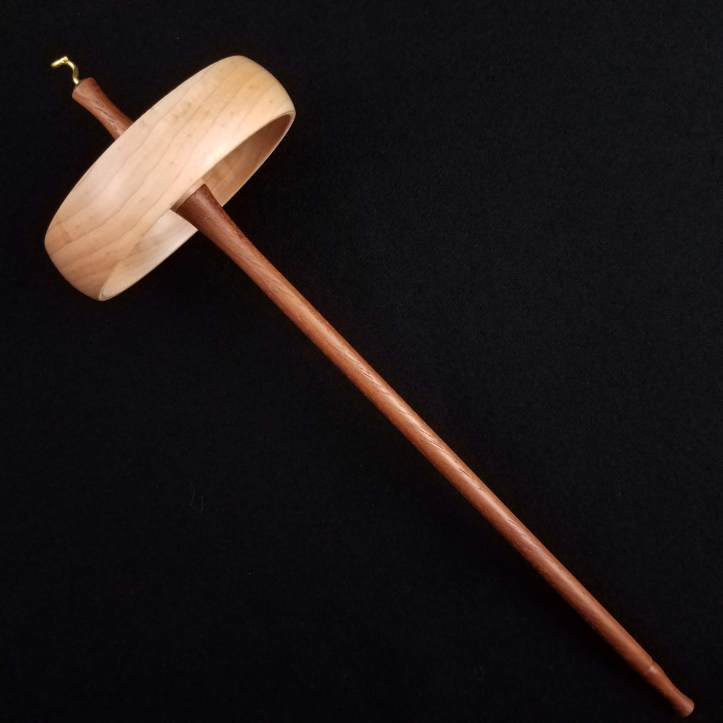
Length Range: 10″
Weight Range: 18 g to 39 g
Characteristics: A suspended spindle. The pig tail hook allows the singles yarn to feed off the top of the spindle very close to the shaft, reducing the wobble one encounters in some top whorl spindles. The whorl averages 3″ in diameter. Some large top whorls do not have the thick, hollowed-out whorl which creates a rim-weighted effect, but these are much less common.

Here is a photo showing a large and small top whorl together, to provide a sense of scale.

A special class of Spanish Peacock drop spindles (bottom or top whorl) are affectionately called “Do Not Drop” spindles because of the cut out designs in the whorls. These cut out areas increase the rim-weighted effect and make the spindle even lighter. However, they are also inherently more delicate – hence the name!

You can see more examples in this blog post.
A key characteristic of Spanish Peacock top whorls (small and large) is the lack of a notch to keep the singles yarn from sliding around the whorl as you’re trying to spin. If you’re struggling to spin on a top whorl without the notch, you can catch my video tutorial here.
Turkish Spindle

Length Range: 8″ (ish)
Weight Range: 23 g to 37 g
Characteristics: Can be used supported or suspended via a half-hitch around the knob at the top of the shaft. One of the rarest of Spanish Peacock spindles, the whorl is formed by crossed interlocking arms. If the cop (in this case called a “turtle”) is wrapped correctly around the arms, the result is a center-pull skein.

Lap Bowl

Characteristics: The lap bowl, stemmed lap bowl, or chalice bowl, is designed to be cradled between the thighs while spinning. Sometimes bowl include a small divot in the center to help keep the spindle tip in one place while spinning.

Spindle Bowl
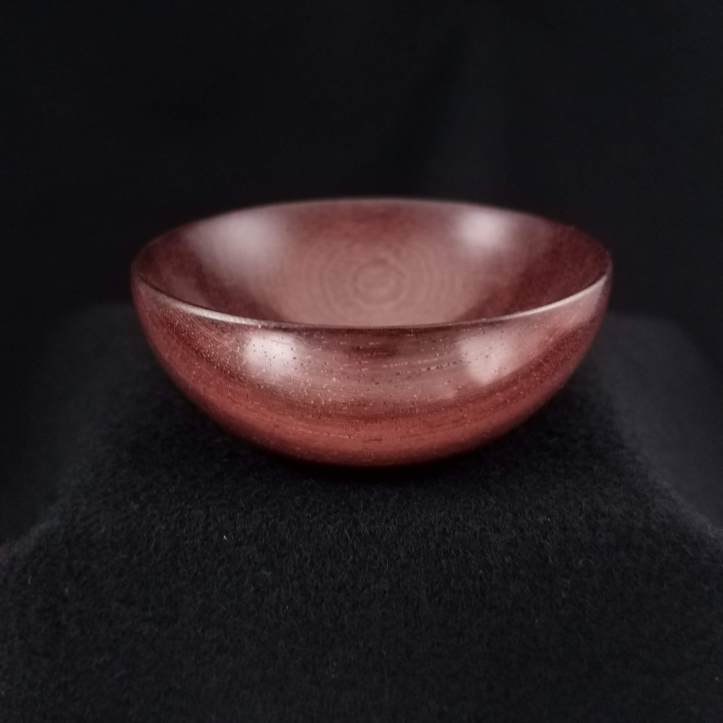
Characteristics: The spindle bowl, sometimes also called a rice bowl, is designed to rest on a surface while spinning. The bowls with a curved base can fit on a lap or flat surface, whereas bowls with a flat base need to be used on a table, floor, or similar surface.

